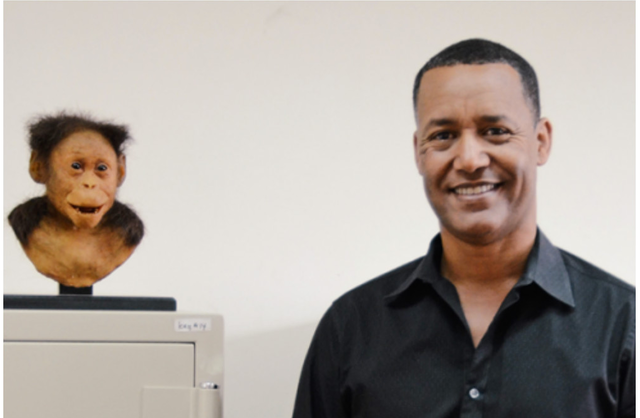 Paleoanthropologist Zeresenay Alemseged beside his discovery, a 3.3 million year old child, an early species in humankind’s lineage. (Image by Amy Maxmen. Ethiopia, 2014.)
Paleoanthropologist Zeresenay Alemseged beside his discovery, a 3.3 million year old child, an early species in humankind’s lineage. (Image by Amy Maxmen. Ethiopia, 2014.)
By AMY MAXMEN
Two hammers, two shovels, four rifles. They carried their own tools. Zeresenay Alemseged, a young and driven Ethiopian fossil hunter, joined by four armed soldiers and a government official, was on a mission to the Afar Depression, a region shaped like a tornado in Ethiopia’s Great Rift Valley. The Afar is bone-dry, scorching hot, and riddled with scorpions and vipers. It is regularly shaken by earthquakes and sinking deeper into the Earth as the converging tectonic plates beneath it pull apart, and molten magma bubbles up through the cracks. When the magma cools, it forms sharp, basaltic blocks.
Along the road, the boulders blocked Alemseged’s path. He had to stop the car, lift the boulders, drive further, repeat. Dry riverbeds were smoother, but frequently the tires sank in the fine sand, and the men, sweating in the afternoon sun, pushed the jeep onward.
Alemseged was headed to the most dangerous spot within the Afar, which even Indiana Jones-types avoided because of constant conflicts between local tribes. The armed soldiers were his security. Alemseged had no salaried scientific position, and refused to accompany teams led by accomplished researchers going to safer areas with fat grants. If he struck out on his own, he felt sure he could discover academic gold: ancient traces of humankind’s past. This meant funding the expedition out of pocket. “I was the driver, so I didn’t need to pay a driver; I was the cook, so I didn’t need to pay a cook; and I was the only scientist,” Alemseged said.
His aim was to explore an area called Dikika, across from a bank on the Awash River where an American paleontologist, Donald Johansen, had discovered Lucy in 1974. Her ancient skeleton’s partially human, partially chimpanzee features were a clear indication of our descent from the apes. Dikika was the logical next place to look for more fossils, but no one had done so because of the risk presented by battles waged over water and land between the Afar and the Issa, pastoral tribes who inhabit Dikika. But Alemseged, who goes by Zeray (pronounced Zeh-rye), was not deterred.
Alemseged’s bare-bones team reached a vast plain of sand and volcanic ashes. He knew this sediment yielded the type of fossils he was after. In December of 2000, one of the men spotted the top of a skull the size of a small orange in the dirt. Slowly, over a period of years, he and his colleagues carefully unearthed a petite skeleton of a child who had likely died in a flood and been buried in soft sand, 3.3 million years ago. She was a member of Lucy’s species, Australopithecus afarensis, from a period about halfway between today and the time when our lineage went one way and that containing chimpanzees went the other. In 2006, Alemseged and his colleagues published their findings in Nature.
The child was named Selam—a word for peace in several Ethiopian languages, a wish to end the fighting in Dikika. Selam’s gorilla-ish shoulder blades and long fingers betrayed a penchant for swinging on braches. But bones at the base of her head showed that she held it upright and therefore walked on two legs. The size of her skull suggested her brain developed slowly through early childhood, a distinct characteristic of humans from long before modern humans evolved.
“It’s the earliest child in the history of humanity,” Alemseged said, enunciating each word slowly. “That discovery was 100 percent Ethiopian. It was by Ethiopians, on Ethiopian land, led by an Ethiopian scientist.”
Read the full story at Nautilus »
–
Related:
Tadias Interview with Zeresenay Alemseged (2009)
Watch: Dr. Zeray explains the discovery of Selam
Join the conversation on Twitter and Facebook.

























